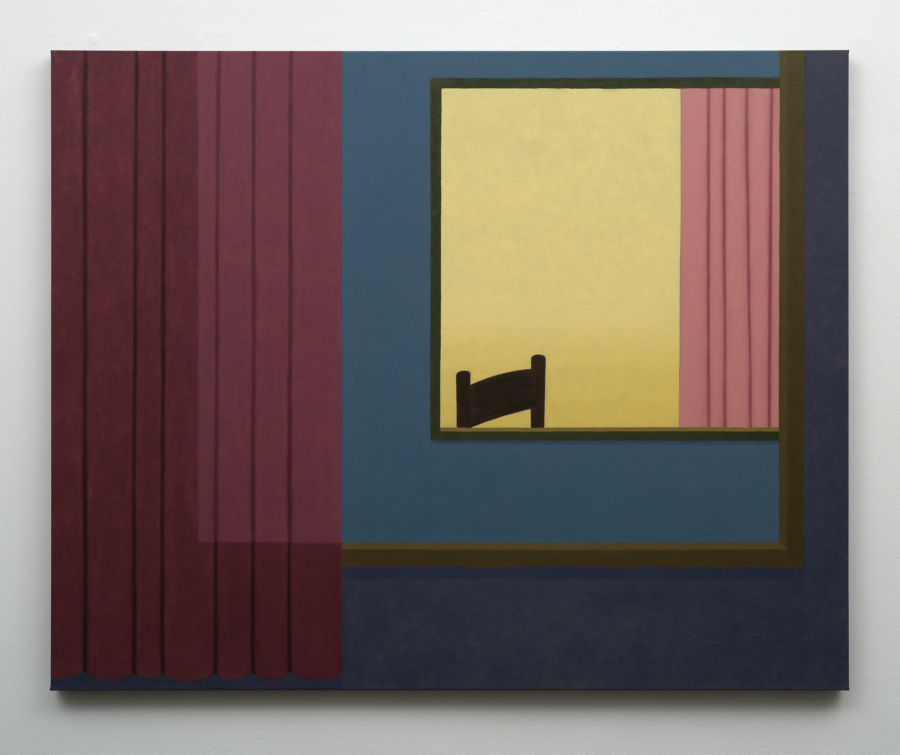May 7, 2009
Download as PDF
View on Brooklyn Rail
Paul Mogensen and Stephen Rosenthal share the new BLT space on the Bowery. The works on view were selected from earlier exhibitions, inviting re-evaluation in light of changing issues and a new architectural setting. It is a special chance to see the work again: usually a worthwhile exhibition is sent off to purchasers, or returned in whole or part to the artist; in either case, rarely are fans given a chance to view the works together again with anything resembling the impact of their first presentation. This show is a promising step toward correcting that situation.
Considering the artists in alphabetical turn, Mogensen is represented by three 8-foot-square blue paintings: “Black Widow,” “Open Work Painting #2,” and “Open Work Painting #3.” All were seen, along with two others from the group, in his 1997 exhibition at Art and Industry. Mogensen’s particularly thoughtful response to painting is consistently forward-looking, well-informed, and highly regarded. He is uninterested in titles, except in the many ways a work can acquire a title independent of the painter’s intention, so “Black Widow” is a referential tag acquired sometime during the painting’s history. The date is 1993, and it is the first of the “Open Work” (or Openwork) group, which refers to art or craftwork characterized by perforations through the form. The paintings are grid-based. A single, bravura layer of carefully-controlled ultramarine blue, from darkest tonality to lightest, defines the square expanse of field. In the “Open Work” paintings, Mogensen treats an eight-by-eight-foot canvas as a squared grid, with the center square occupied by a spiral. The spiral might be painted in spectrum colors, or it might simply be reserve ground or underpaint. Once established, any number of similar instances of spiral-defined circles-within-squares, or cutout circular holes (which are not at all real holes, but complicated constructions involving carpentry and upholstery skills) might appear emblematically on adjacent squares. These elements introduce a concept of “thing/no-thing” with the spiral representing one type of solution, and cutout space representing another. The artist is testing the limits of minimalism’s ability to incorporate display of imagery within an overall image: the macro determined by the micro, and vice-versa. He is also interested, as was Joyce, in the survival of formal vehicles, the connection of archaic past to concerns of the present (the sources for the “Open Work” series include Saxon and Viking belt buckles and other ornamental metalwork).
In these works Mogensen achieves an imagistic synthesis of fully expressive pictorial frontality with the perforated, die-cut object. The group as a whole is a tour-de-force of advanced painting and resonant history, a unique challenge to anyone concerned with paint and subject matter. The spirals are, for the most part, multi-colored, approximating the visible spectrum, and function as loci of rich significance: anthropological, mathematical, and spiritual. The viewer is invited to explore the work through any, or all, of these gates.
Stephen Rosenthal brings to our attention a way of looking at painting through the process of seeing without awakening our desire to name what it is we see. He works with a palette of tones that roughly approximate the color of the stretched linen support, accumulating a visual record of his daily meditations on the interaction between eye+paint+support+mode. These meditations take place extremely close to the grid of tightly woven linen, and the effect of his activity seems to stop as close to filling the valleys of the weave as possible, as if he were reluctant to violate the integrity of his given support. (In this respect both painters bring to mind an important 1969 essay, “Field and Vehicle in Image Signs” by Meyer Schapiro.) In spite of this reluctance, however, Rosenthal paints intuitively, by the seat of his pants, and one can discern areas of absolute destruction in his struggle to join field and image to a single whole.
Rosenthal’s process softens rather than reinforces the tautness of the linen support, creating a consistent problem at the sides of the painting, where the middle-ground he prefers as his “visual” space and the all-too-insistent “reality” of the wall must finally meet. This reluctance to define a planar foreground can contribute to a somewhat fugitive appearance, as if the painting and its support were somehow mismatched. Fortunately, for this writer, the architectural elements at BLT combined to present Rosenthal’s work in a setting it requires. Three of the paintings are the largest the artist has done to date: “Seven Bridges,” “Hunts Point,” and “Tilsbury”—all painted between 1999 and 2001—measure nearly 95 inches by 48 inches. An additional painting, “Untitled” (1999), is 78 × 45. The eight-foot paintings were part of a group that was shown at Stark Gallery in 2003. The three paintings on view are so sensitively interconnected that I felt an incompleteness until the painter reminded me that there was a fourth that could not be borrowed for the exhibition. The visual pulse carrying so eloquently from one work to the next made the missing work palpable, like an interrupted melody. It demonstrates how Rosenthal found a new direction by adding specifically intuitive yet universal visual elements as an architectural correction, one that was beautifully emphasized by BLT’s walls of porous, flat-troweled stucco, and an abundance of natural eastern light.



